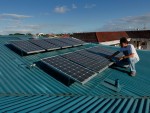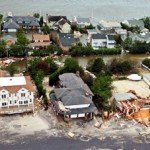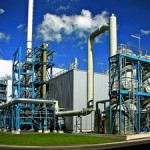
The Arctic climate is changing faster than some scientists expected. A continuing decline in summer sea ice, warmer temperatures, changes in vegetation, and other indicators signal polar changes that affect the rest of the globe. Black Carbon is contributing to this warming. Scientists say much of the black carbon in the Arctic comes from biomass and fossil fuel burning in North America and Eurasia.
“Carbon is dark in color and absorbs solar radiation, much like wearing a black shirt on a sunny day. If you want to be cooler, you would wear a light-colored shirt that would reflect the sun’s warmth,” said Tim Bates, a research chemist at NOAA’s Pacific Marine Environmental Laboratory (PMEL) in Seattle and co-lead of the U.S. component of the study. “When black carbon covers snow and ice, the radiation is absorbed, much like that black shirt, instead of being reflected back into the atmosphere.”
Also participating in the Coordinated Investigation of Climate-Cryosphere Interactions (CICCI) Project are scientists from Norway, Russia, Germany, Italy and China. The goal is to coordinate more than a dozen research activities so they are done concurrently providing, for the first time, a vertical profile of black carbon’s movement through the atmosphere, its deposition on snow and ice surfaces, and its affect on warming in the Arctic.
“We need to better understand the behavior of black carbon in the Arctic,” said Patricia Quinn, co-lead of the NOAA portion of the project and a research chemist at PMEL. “This coordinated study will give us a snapshot so we can see all of it at once.”
Observations will be taken aboard a ship, from land-based sites, and from the air using manned and unmanned aircraft and balloons. The study will run through May 15 out of Svalbard, Norway.
The NOAA part of the study, called the Soot Transport, Absorption, and Deposition Study (STADS), will be conducted between April 7 and May 6, using NOAA’s two Manta aircraft. Aboard each aircraft will be a package of instruments to measure aerosol size, number, light absorption and chemical composition. For the first time, a PMEL black carbon sensor will also be aboard the Mantas.
A Norwegian unmanned aircraft will measure incoming radiation from the sun and the albedo, or reflectivity, of snow and ice covered surfaces, providing another first – the first time multiple unmanned vehicles will be flown with the goal of measuring soot in the atmosphere and its impact on surface albedo.
NOAA also will collect falling and newly fallen snow for black carbon and chemical tracer analysis. Chemical tracers will yield information on the source of the black carbon, which is essential for developing strategies for mitigating the impact of black carbon on Arctic climate.
Surface snow characteristics and albedo also will be measured from a snowmobile pulled sled on Svalbard at the Holtadalfohna Plateau, Kongsfjord fast ice, and the sea ice north of Spitsbergen. Robert Stone of the Cooperative Institute for Research in Environmental Sciences will lead that study.
Led by Bates and Quinn, the NOAA team also includes PMEL engineers Scott Stalin, Nick Delich, and Dirk Tagawa; Joint Institute for the Study of Atmosphere and Ocean scientists Jim Johnson and Drew Hamilton, and NOAA scientist Derek Coffman.
Among the participating institutions and research centers are the Arctic and Antarctic Research Institute, the Alfred Wegner Institute, the Institute of Atmospheric Sciences and Climate of the Italian National Research Council, the Chemistry Department of Florence University, the Norwegian Institute for Air Research, the Northern Research Institute, the Norwegian Institute for Polar Research, and the Chinese Academy of Meteorological Sciences.
In its Arctic Vision and Strategy, NOAA identified strengthening foundational science to understand and detect Arctic climate and ecosystem changes as one of its main goals.
NOAA’s mission is to understand and predict changes in the Earth’s environment, from the depths of the ocean to the surface of the sun, and to conserve and manage our coastal and marine resources.

Source: NOAA (National Oceanic and Atmospheric Administration).














